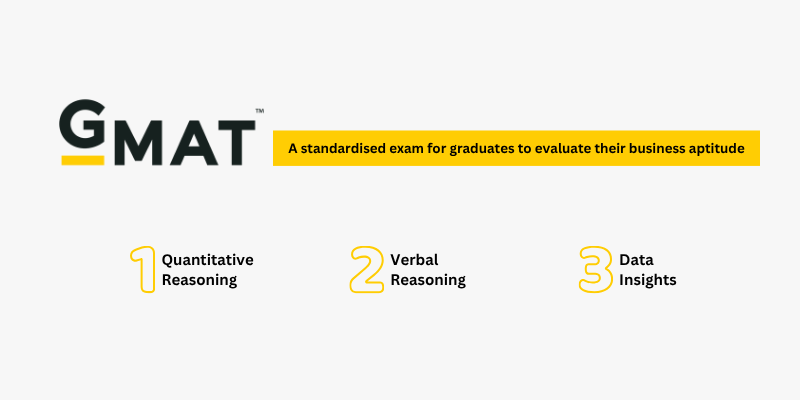What’s on the GMAT in 2025? A Clear Breakdown for Serious Test-Takers

What’s Tested Isn’t the Hard Part
The GMAT doesn’t just assess what you know. It evaluates how you handle pressure, uncertainty, and time constraints using material that seems basic on the surface.
That’s why people who’ve already done hundreds of practice questions still end up stuck. And it’s why even high scorers sometimes walk out of the test center knowing they didn’t perform the way they’d hoped.
If you want to prep well, it’s not enough to know the topics. You need to understand how the test is built – and how your preparation needs to match its structure, not just its surface.
This guide breaks down what’s on the GMAT Focus Edition (the current version of the test as of 2024), how each section works, and what it actually asks of you.
Section Overview: The Structure of the GMAT Focus Edition
The GMAT now includes three sections:

- Quantitative Reasoning – 21 questions in 45 minutes
- Verbal Reasoning – 23 questions in 45 minutes
- Data Insights – 20 questions in 45 minutes
That’s it. No Analytical Writing. No separate Integrated Reasoning. Just three tightly timed sections with questions drawn from a pool of official formats.
Each section is adaptive, meaning the difficulty of questions adjusts based on your performance. You also get access to a Review & Edit screen at the end of each section, where you can revisit up to three flagged questions (if you have time remaining).
1. Quantitative Reasoning: Math Without a Calculator
This GMAT quantitative section tests high school-level math – arithmetic, algebra, basic statistics – but under conditions that make it easy to misread, miscalculate, or rush.
You’ll see only one question type:
- Problem Solving: Standard multiple-choice math questions. You’ll need to work quickly and avoid traps designed to waste time.
What trips people up here isn’t the math. It’s the sequencing: when to solve, when to guess, when to move on. This section rewards strategic decision-making more than raw computation.
2. Verbal Reasoning: Comprehension and Analysis
The Verbal section isn’t about knowing big words. It’s about:
- Recognizing flawed logic
- Parsing complex arguments
You’ll face two types of questions:
- Reading Comprehension: Dense academic-style passages followed by inference and detailed questions.
- Critical Reasoning: Short arguments with a twist – your job is to strengthen, weaken, or explain.
Time pressure makes this section harder than it looks.
3. Data Insights: Where IR and Logic Meet
This section is new in name, but familiar in format to anyone who’s seen Integrated Reasoning.
Expect to analyze:
- Data Sufficiency: You’re not solving – you’re deciding whether the information can be used to solve. This format is unique to the GMAT and often counterintuitive at first.
- Multi-source data across tabs or charts
- Sortable tables
- Graphs and visuals
- Paired questions that require you to evaluate two things side-by-side
What’s different in the Focus Edition is that Data Insights now contributes to your total score – it’s not a side section anymore. And it blends both quant and verbal reasoning, meaning a single prompt might require math logic and reading comprehension in one go.
This is where your ability to think clearly across formats – visual, verbal, numeric – really matters.
How the GMAT Is Scored (and What Counts Most)
The total score ranges from 205 to 805.
Unlike the old test, all three sections now contribute equally to your GMAT score. The weighting is even – no bonus for crushing Quant if your Verbal or Data Insights sections underperform.
That means most top scorers are well-rounded, not just math-heavy. This also changes how you should prepare: over-indexing on a single section may cap your total potential.
What the GMAT Actually Tests (That Most Prep Skips Over)
Most test prep materials will tell you what’s covered: math topics, data analysis, and reasoning categories. That’s helpful – to a point.
But here’s what the GMAT really tests:
- Can you notice what matters and ignore what doesn’t?
- Can you reason under pressure without second-guessing yourself?
- Can you spot patterns, not just memorize solutions?
That’s where many students fall short. Not because they don’t know the content, but because they don’t practice how to think in test conditions.
What Serious Prep Looks Like (And Why Most Courses Don’t Offer It)
A good GMAT prep course doesn’t just show you the material. It shows you how to study in a way that builds repeatable decisions under pressure.
That means:
- Feedback while you’re solving – not just after you submit
- Structured progression, not random question banks
- Official GMAT questions, not imitations
Gurutor was designed around this exact problem: most students don’t struggle during lessons – they struggle between them. Gurutor acts like a tutor who doesn’t leave when the video ends. It trains the moment-to-moment choices that affect your score.
FAQs: Fast Answers for First-Time Test-Takers
Is the GMAT still four sections?
No. As of 2024, the GMAT Focus Edition has three sections: Quant, Verbal, and Data Insights.
Is there still an essay?
No. The AWA section was removed in the GMAT Focus Edition.
How long is the GMAT?
2 hours and 15 minutes, with an optional 10-minute break between sections.
Can I review my answers?
Yes – at the end of each section, you can review up to three flagged questions.
How is it scored?
You’ll receive a score from 205 to 805, with each section contributing equally.
Final Thought
The GMAT isn’t about memorization. It’s about how you think when every second counts. If you’ve plateaued, it’s likely not your ability – it’s your study process.
Whether you’re aiming for a 655+ score or just starting fresh, it’s worth asking: is your prep teaching you the test, or just showing you the content?
If you’re not sure, try the first Gurutor module free. It’ll show you exactly how prep can feel different – and work better.
